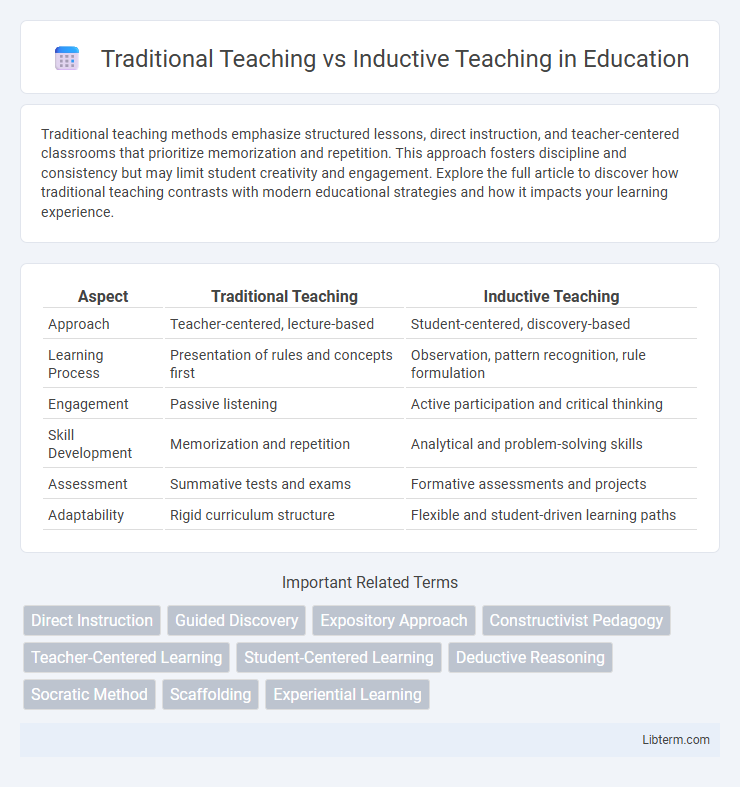Traditional teaching methods emphasize structured lessons, direct instruction, and teacher-centered classrooms that prioritize memorization and repetition. This approach fosters discipline and consistency but may limit student creativity and engagement. Explore the full article to discover how traditional teaching contrasts with modern educational strategies and how it impacts your learning experience.
Table of Comparison
| Aspect | Traditional Teaching | Inductive Teaching |
|---|---|---|
| Approach | Teacher-centered, lecture-based | Student-centered, discovery-based |
| Learning Process | Presentation of rules and concepts first | Observation, pattern recognition, rule formulation |
| Engagement | Passive listening | Active participation and critical thinking |
| Skill Development | Memorization and repetition | Analytical and problem-solving skills |
| Assessment | Summative tests and exams | Formative assessments and projects |
| Adaptability | Rigid curriculum structure | Flexible and student-driven learning paths |
Introduction to Teaching Methods
Traditional teaching relies on a teacher-centered approach emphasizing direct instruction and memorization, often employing lectures and rote learning techniques. Inductive teaching, by contrast, promotes student-centered learning where learners derive general principles through observation, experimentation, and problem-solving activities. Both methods offer distinct advantages in fostering knowledge acquisition, with induction enhancing critical thinking and engagement compared to the structured rigidity of traditional approaches.
Defining Traditional Teaching
Traditional teaching emphasizes a teacher-centered approach where information is delivered through lectures, direct instruction, and rote memorization. This method relies heavily on structured, sequential content presentation and standardized assessments to evaluate student learning. It contrasts with inductive teaching, which prioritizes student engagement and discovery-based learning.
Understanding Inductive Teaching
Inductive teaching emphasizes student-centered learning by encouraging exploration and discovery, allowing learners to build concepts through active engagement and observation. This approach fosters deeper comprehension by connecting new knowledge with prior experiences, promoting critical thinking and problem-solving skills. Unlike traditional teaching, which relies heavily on direct instruction and rote memorization, inductive teaching supports conceptual understanding and long-term retention.
Key Features of Traditional Instruction
Traditional teaching is characterized by teacher-centered instruction where knowledge is directly transmitted through lectures and rote memorization. It relies heavily on structured curricula, standardized assessments, and passive student roles focused on listening and repeating information. Emphasis is placed on fixed content delivery, uniform learning pace, and authoritative classroom management.
Principles of Inductive Learning
Inductive teaching centers on the principle of learning through observation, pattern recognition, and generalization, allowing students to construct knowledge actively rather than passively receiving information. This approach emphasizes student engagement with concrete examples and problem-solving activities to derive concepts and rules independently. Effective inductive learning fosters deeper understanding and critical thinking skills by encouraging learners to infer principles from specific cases.
Classroom Dynamics: Structured vs Exploratory
Traditional teaching emphasizes a structured classroom dynamic where the teacher delivers predetermined content and students follow set procedures, fostering consistency but limiting spontaneity. Inductive teaching promotes an exploratory environment, encouraging student inquiry and active problem-solving, which enhances critical thinking and engagement. This shift from passive reception to active discovery transforms classroom interactions and supports personalized learning experiences.
Student Engagement and Participation
Traditional teaching often relies on lecture-based methods, leading to passive student engagement and limited participation. Inductive teaching encourages active learning by guiding students to discover principles through observation and analysis, resulting in higher engagement levels and increased participation. Empirical studies show that inductive approaches enhance critical thinking and foster collaborative learning environments.
Learning Outcomes and Effectiveness
Traditional teaching emphasizes direct instruction and rote memorization, often resulting in surface-level understanding and limited critical thinking skills. Inductive teaching, which encourages students to explore patterns and derive principles independently, enhances deeper comprehension and promotes higher-order cognitive abilities. Studies show inductive methods improve long-term retention and application of knowledge, leading to more effective learning outcomes compared to traditional approaches.
Advantages and Challenges Compared
Traditional teaching offers structured curriculum delivery and clear learning objectives, promoting teacher control and consistent content coverage. Inductive teaching fosters active student engagement, critical thinking, and deeper comprehension by encouraging learners to observe patterns and infer rules. Challenges of traditional teaching include limited student interaction and passive learning, while inductive methods may require more time and skilled facilitation to guide discovery effectively.
Choosing the Right Approach for Your Classroom
Traditional teaching emphasizes a teacher-centered approach with structured lessons and direct instruction, ideal for delivering foundational knowledge efficiently. Inductive teaching encourages student-centered exploration and discovery, fostering critical thinking and deeper understanding by allowing learners to identify patterns and concepts independently. Selecting the right approach depends on classroom goals, student learning styles, and subject complexity, balancing the need for clarity with opportunities for active engagement.
Traditional Teaching Infographic

 libterm.com
libterm.com